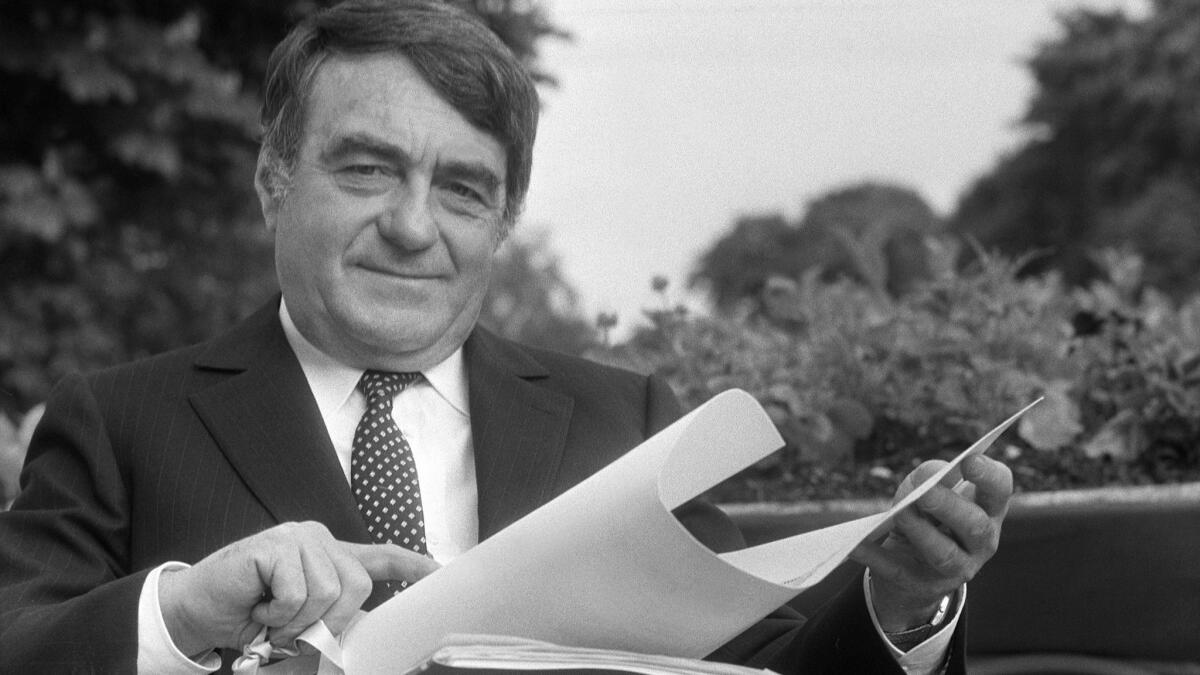Appreciation: Director Claude Lanzmann’s ‘Shoah’ changed our understanding of the Holocaust — and altered documentary filmmaking

It is not given to most filmmakers to change the world, but French filmmaker Claude Lanzmann, who died Thursday at age 92, did it not once but twice. And with the same film.
That would be 1985’s “Shoah,” a massive documentary on the Holocaust — a word that Lanzmann, a man of passionate likes and dislikes, could not abide — that altered everything it touched.
On the most basic level, because of the great success it enjoyed at its imposing, nearly 10-hour length, “Shoah” changed the game for the documentary form.
Following in its footsteps were everything from the landmark civil rights series “Eyes on the Prize” to the seven-hour, Oscar-winning “O.J.: Made in America” to the proliferation of multi-part docs on today’s cable platforms. Great length would never again be seen as an obstacle to audience acceptance.
On a more profound level, however, “Shoah” took one of the most unimaginable events in modern history and helped us come to grips with it in a way that would not seem possible for those who had not been personally involved.
Taking for his title the Hebrew word from a passage in the Book of Isaiah where the prophet says “there will come a catastrophe such as you have never known,” Lanzmann immersed himself in these events, capturing their enormity in a devastating way.
It took the director seven years to shoot “Shoah” in 14 countries and an additional five years to edit it down from 350 hours of footage.
The result, Lanzmann insisted, was not a conventional documentary: “I think that the film, using only images of the present, evokes the past with more force than any historical document,” he said.
Lanzmann achieved what he did in part by his ability to be relentless and unforgiving with those he talked to, for instance, assuring a former S.S. officer that the interview he had agreed to was audio only but clandestinely filming it with a hidden camera.
This righteous zeal came from an unwillingness to cut a break for anyone who had essential testimony, from a feeling that his allegiance had to be to the truth of history and to the millions who had died.
The director tracked down and compelled to testify even the most unwilling of witnesses, like Filip Muller, a former sonderkommando at Auschwitz who detailed what it was like to deal with dead bodies in the camp’s crematoria.
Perhaps the most affecting of “Shoah’s” interviews was with Abraham Bomba, a barber at Treblinka’s death camp, whose story Lanzmann insists must be told, even as the teller broke down on screen.
“No one can describe it, re-create what happened here,” a camp survivor tells Lanzmann, returning to the site of atrocities. “Even I, here, now.”
Massive as it was, “Shoah” could not contain all the compelling footage Lanzmann shot, so the director returned again and again to his subject, creating four other documentaries from footage he’d already shot.
The most impressive of these, completed when Lanzmann was 87, is “The Last of the Unjust,” based on a series of interviews the director could not forget about. “They continued to dwell in my mind and haunt me,” he wrote. “I was the custodian of something unique.”
That something unique was the thoughts and reminiscences of Benjamin Murmelstein, who died in 1989. Murmelstein had been a rabbi in Vienna but at the time of filming at his home in Rome he was the last surviving head of a Judenrat, the Jewish councils set up to administer, under Nazi supervision, ghettos and concentration camps.
Murmelstein had been the head of the Judenrat at the notorious Theresienstadt camp, a Nazi model ghetto in the Bohemian countryside just outside of Prague whose bogus pleasures were trumpeted to the world in propaganda and film as “Hitler’s gift to the Jews.”
“The Last of the Unjust” is exceptionally powerful. An essay/meditation on the nature of good and evil, heroism and expediency, this film tackles head-on the question of whether people like Murmelstein were collaborators who should be condemned, if not executed, or realists who made the best of a completely nightmarish situation. Those who think this is a black-and-white issue will be surprised, as Lanzmann himself appears to have been by what was said there.
To hear Murmelstein describe the kinds of behavior that went on in the camp and then provocatively sum it up by saying “every martyr is not a saint,” is to get a whiff of insight into unknown reality that no one but Lanzmann was able to uncover.
As the interview winds to a close, Murmelstein takes a breath and says to his relentless interrogator, “I never pulled away from danger. You’re the last danger to come my way and I’m not afraid of you either.”
Lanzmann never pulled away from danger either, and his success in getting viewers to not only think about the unthinkable but to begin to be able to comprehend it were accomplishments of the highest order.
More to Read
Only good movies
Get the Indie Focus newsletter, Mark Olsen's weekly guide to the world of cinema.
You may occasionally receive promotional content from the Los Angeles Times.











